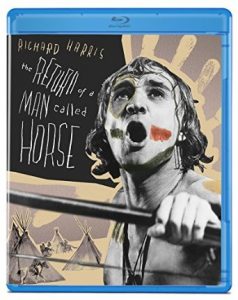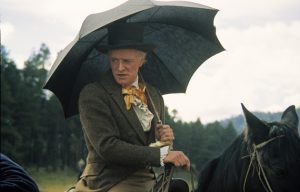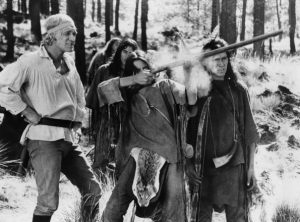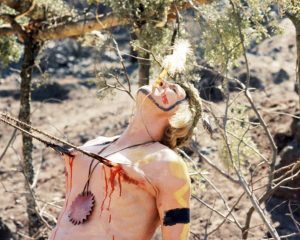The following title is being released on Blu-ray and DVD on June 21st by Olive Films.
 Back in 1970, A Man Called Horse became something of a surprise success at cinemas. According to reports from those who saw it during its original release, the story was thought of as unique. By today’s standards it’s certainly dated and in some respects politically incorrect, but it clearly spoke to viewers in its day. Naturally, a sequel followed in 1976. Called The Return of a Man Called Horse, the film was also a success. Released on DVD long ago, it is now out of print and copies have been listed online for as much as $200 dollars. So it’s with great relief that Olive Films are releasing a reasonably priced Blu-ray and DVD of the flick this very week. Now you can own it without having to pay out an astronomical sum. But how does the actual movie compare with the original title?
Back in 1970, A Man Called Horse became something of a surprise success at cinemas. According to reports from those who saw it during its original release, the story was thought of as unique. By today’s standards it’s certainly dated and in some respects politically incorrect, but it clearly spoke to viewers in its day. Naturally, a sequel followed in 1976. Called The Return of a Man Called Horse, the film was also a success. Released on DVD long ago, it is now out of print and copies have been listed online for as much as $200 dollars. So it’s with great relief that Olive Films are releasing a reasonably priced Blu-ray and DVD of the flick this very week. Now you can own it without having to pay out an astronomical sum. But how does the actual movie compare with the original title?
 Set in the 1800s, the story follows an English aristocrat named John Morgan (Richard Harris). After being captured and then integrating himself into a Sioux Nation group called Yellow Hands, he has returned home to the UK. However, he finds himself disconnected from his old life and decides to return to South Dakota and rejoin his adopted family. In the meantime, nasty fur trader Zenas (Geoffrey Lewis) has paid a tribe of warriors to wipe out the Yellow Hands. The majority of Yellow Hands men have been killed and the women, children and youngsters ousted from their land. Morgan finds and teaches them to fight back. But to do so, he must also pass a painful ceremony to earn favor from the spirit world.
Set in the 1800s, the story follows an English aristocrat named John Morgan (Richard Harris). After being captured and then integrating himself into a Sioux Nation group called Yellow Hands, he has returned home to the UK. However, he finds himself disconnected from his old life and decides to return to South Dakota and rejoin his adopted family. In the meantime, nasty fur trader Zenas (Geoffrey Lewis) has paid a tribe of warriors to wipe out the Yellow Hands. The majority of Yellow Hands men have been killed and the women, children and youngsters ousted from their land. Morgan finds and teaches them to fight back. But to do so, he must also pass a painful ceremony to earn favor from the spirit world.
While it is attempting to paint a more complex and naturalistic portrait of indigenous peoples, this is a 40 year old movie and the ideas don’t exactly come across as forward-thinking today. Even during its original release, there were complaints about the idea of a white man inspiring and leading a tribe to victory. Others critiqued the film for its odd casting (the majority of the movie was shot in Mexico and features local extras as Sioux members). I tend to agree with these evaluations – they all feature important points and these problems are very noticeable.
 On the positive, there’s a grand, sweeping scale to the film that the original never possessed. The widescreen photography really captures some incredible natural sights, including a herd of buffalo racing along the plains at sunset, as well as some beautiful natural rock formations. These backdrops are so immense that they really add to the production value, as does a sweepingly gorgeous orchestral score by Lawrence Rosenthal. It all looks and sounds especially great in high definition. There are a few grainy moments (which has more to do with the original material than the transfer), but overall the picture is quite strong.
On the positive, there’s a grand, sweeping scale to the film that the original never possessed. The widescreen photography really captures some incredible natural sights, including a herd of buffalo racing along the plains at sunset, as well as some beautiful natural rock formations. These backdrops are so immense that they really add to the production value, as does a sweepingly gorgeous orchestral score by Lawrence Rosenthal. It all looks and sounds especially great in high definition. There are a few grainy moments (which has more to do with the original material than the transfer), but overall the picture is quite strong.
 The lengthy, bloody and wince-inducing spirit ceremony is a bit exploitative, but Harris is always entertaining to watch (he has a couple of entertainingly over-the-top emotive moments) and the battle scenes featuring various groups in conflict are well staged and even exciting. There’s even an impressive explosion at the end, adding intensity to the feature. Reportedly, George Lucas was so impressed by what he saw in the work of director Irvin Kershner that he hired him to helm the first Star Wars sequel, The Empire Strikes Back. And it is easy to see why. It’s clear too that the filmmaker’s skills really added a sense of epic scope to the production.
The lengthy, bloody and wince-inducing spirit ceremony is a bit exploitative, but Harris is always entertaining to watch (he has a couple of entertainingly over-the-top emotive moments) and the battle scenes featuring various groups in conflict are well staged and even exciting. There’s even an impressive explosion at the end, adding intensity to the feature. Reportedly, George Lucas was so impressed by what he saw in the work of director Irvin Kershner that he hired him to helm the first Star Wars sequel, The Empire Strikes Back. And it is easy to see why. It’s clear too that the filmmaker’s skills really added a sense of epic scope to the production.
Interestingly enough, this feature was successful enough to warrant a sequel called Triumphs of a Man Called Horse (1982), but by then Harris wasn’t in the best of shape and he only appears in a brief role. The third was not well regarded and remains a little known footnote in the series. The Return of a Man Called Horse has plenty of issues, but enthusiasts of the film will certainly like what they see in this release; additionally, there’s no criticizing the slick look and impressive scope of this follow-up.


